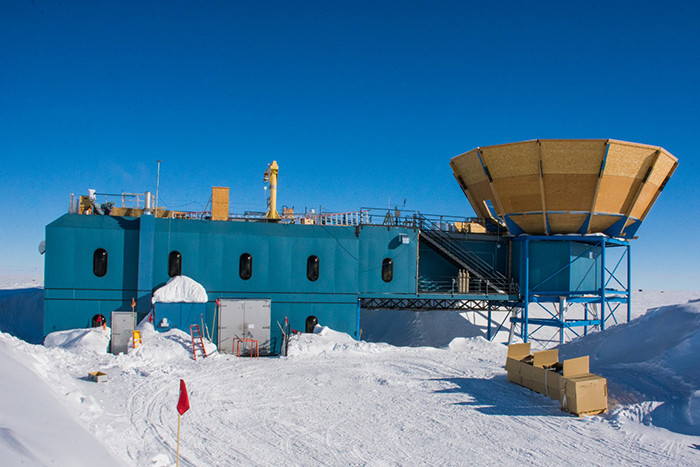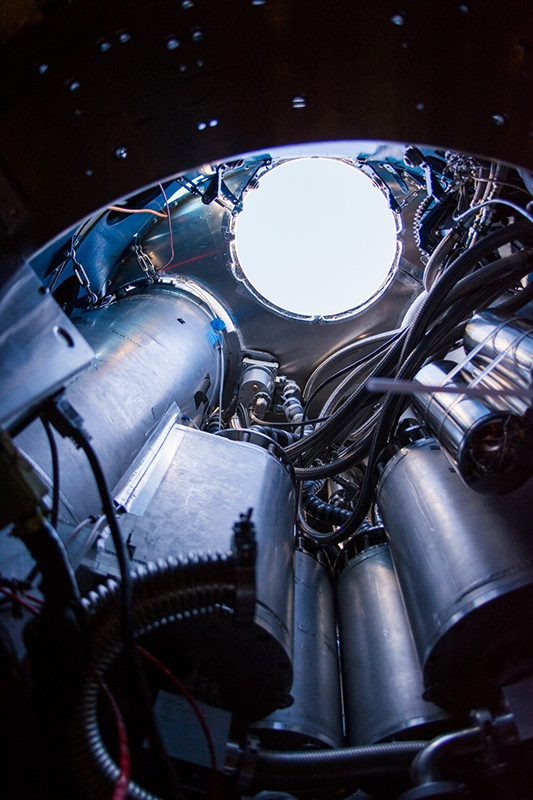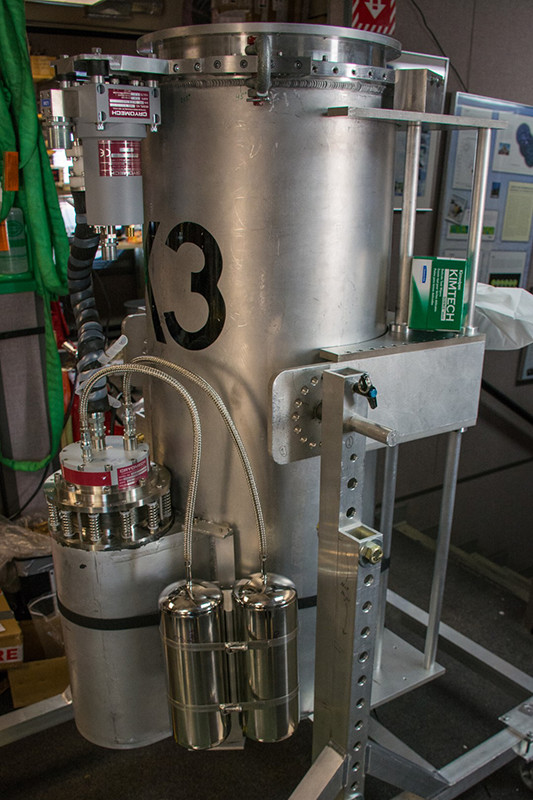
Photo Credit: Mike Lucibella
|
A little ways away from the South Pole station, the Keck Array is shielded from interference reflected
up from the ground behind a protective shroud.
|
Searching for Inflation
How astronomers are overcoming our dusty galaxy’s obstacles and peering into the primordial universe.
By Michael Lucibella, Antarctic Sun Editor
Posted August 1, 2016
At the bottom of the planet, astronomers are peering deep into the ancient cosmos. But first, they have to finish clearing away the galactic dust obscuring their view.

Photo Credit: Mike Lucibella
The Keck Array is made up of five cylindrical receivers to see various microwave wavelengths. Here one is removed to be upgraded.

Photo Credit: Mike Lucibella
Looking up inside the Keck Array at one of the receivers removed for upgrading.
Scientists working at the South Pole are trying to detect the imprints of gravitational waves from when the universe was only a tiny fraction (about one trillionth of a trillionth of a trillionth) of a second old. In doing so, they hope to prove the existence of a period of extreme cosmic expansion in the early universe called inflation, and gain insights towards uniting thus-far incompatible theories of quantum mechanics and general relativity.
“Currently our teams have two major telescopes that we’re running at South Pole,” said John Kovac, an astronomer at the Harvard-Smithsonian Center for Astrophysics and the principal investigator of the project. “What our telescopes are doing is simultaneously going deep, looking for this signature of early universe inflation, while at the same time breaking new ground in measuring these faint galactic signals so we can separate them out.”
The two telescopes, BICEP3 and the Keck Array, are measuring the cosmic microwave background (CMB). It’s a dim glow of microwave radiation, just three degrees above absolute zero that lies behind the stars across the entire sky. The research is supported by the National Science Foundation, which manages the U.S. Antarctic Program.
The South Pole is one of the best spots on Earth for microwave astronomy. At an altitude of over 9,000 feet, there’s little atmosphere above to disrupt incoming light from space. The thin air there is extremely cold and dry, further minimizing atmospheric distortions. Overhead, the same stars are in the sky all of the time and during the winter, it’s dark 24 hours a day.
“This season we were working on the performance of both of those telescopes, upgrading them in various ways,” Kovac said.
The team spent their brief but busy austral summer upgrading the two telescopes. BICEP3 is the larger of the two, and the more advanced. At its heart are now thousands of tiny detectors sensitive to microwave frequencies of light. It’s the third version of the telescope that’s been installed at the South Pole. With each new instrument, its sensitivity has grown by orders of magnitude.

Photo Credit: Mike Lucibella
Out in the lab, one of the Keck Array’s receivers awaits the installation of a new focal plane making it sensitive to the dust in galaxy.
“We started off with tens of pixels. Generation two was hundreds of pixels,” said Zeeshan Ahmed, a physicist at SLAC National Lab. “This is our third generation instrument which consists of thousands of pixels.”
Last year was its first operational winter, and the telescope ran for a shakedown season with half of its detectors installed. After work this summer, the telescope is now scanning the skies with its full complement of detectors.
“We had a good first season, learned a lot about this instrument,” Ahmed said. “This season should be spectacularly better.”
While BICEP3 is investigating in great detail a single wavelength of light, the nearby Keck Array is taking in a much broader spectrum. It’s a cluster of five connected receivers observing wavelengths not covered by BICEP3.
The array is essentially five copies of the previous generation BICEP2 telescope lashed together. The team spent much of the summer installing new detector arrays into the instrument, sensitive to two different microwave frequencies.

Photo Credit: Mike Lucibella
Kirit Karkare works to install the detector’s new focal plane.
“The Keck Array, because of its modularity, means that we can continually upgrade and replace different parts of the telescope as we want, whereas BICEP3 is all focused on one ‘color,’” said Kirit Karkare, an astronomer at the Harvard-Smithsonian Center for Astrophysics.
They’re using the combined capabilities of the two telescopes to probe far into the ancient past of the universe, and sift out the interference in the way. By studying the cosmic microwave background in detail, they hope to uncover evidence of what happened when the universe was a tiny fraction of a second old.
This cosmic microwave background is the oldest light in the cosmos, left over from just 380,000 years after the Big Bang. Before that time, the expanding universe was still too dense and hot for normal matter to coalesce together, or for light to penetrate through the opaque plasma. The background is the last light emitted by that plasma as it cooled, whose light waves have now been stretched into the microwave range by the continually expanding universe.
“Telescopes at the South Pole have been studying the details of the cosmic microwave background for the last two decades,” Kovac said. “They’ve teased out what the universe is made of, what its history and age are… how fast it’s expanding [and] what’s driving that expansion.”
Throughout all of those observations, there have been a few inexplicable features that have cropped up which astronomers can’t explain using conventional theories alone. One of the biggest ones is that the signal from the CMB is just too smooth. Astronomers would have expected that after 13.8 billion years of expansion, it would be clumpier and more uneven; much like an explosion doesn’t create a perfect sphere when it blows up. Similarly, the measured curvature of space caused by gravity is also much flatter than expected.
But scientists think they have a likely explanation for these anomalies.
Previous
1
2
3
Next









